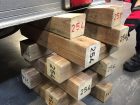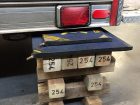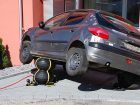
It could be an under ride involving vehicles, buses or trains, a collapse, or even a complicated accident scene.
Are you ready for these lifts? From which type of air bag, the “actual lifting capacity,” and its use and placement in conjunction with cribbing are all extremely important.
Time and time again these difficult extrications challenge our knowledge and skills in a very high-risk, low-frequency event.
In this article, I’m going to touch base on some of the basics regarding air bags that will hopefully help and guide you in the right direction when training and using air bags in the field.
Let’s start with selection.
Every air bag is not created equal. Some look entirely different and some look very similar. However, even the most similar bags can have very important differences.
First up, the low-pressure air bag. These air bags are often refered to as looking like giant pillows. Their lifting capacities can range from 1,000 to 3,200 pounds at a pressure of roughly seven pounds per square inch (psi) and lifting to a height of 22 inches.
While these bags usually provide our greatest lift, they are the weakest of our options and can be very unstable. Electing to use the low-pressure air bag to stabilize an unstable load is a much better option for these bags rather than being used for actual lifting operations.
Medium-pressure bags have been around for some time, however have undergone the most transformation when compared to the other two options.
A good example of this would be the Paratech multi-force air lifting bag. These are dual-stage bags that are sewn together and can provide up to 62,000 pounds of lift and roughly 26 inches of lifting height.
These are great air bags for middle-range operations. They can provide a relatively strong lift option while creating a great amount of space. However, there are two things to remember when selecting, such as stability issues when lifting just like the low-pressure bags, and the actual lifting capacity.
Finally, we have the high-pressure air bags. These bags have a very small starting profile and can have lifting heights from 3.7 to 22 inches. The ultimate separation of these bags from the rest is the lifting capacity, which can range from 5,000 to 210,000 pounds at roughly 174 psi.
The high-pressure air bags can be used in all types of lifting operations. They can be inserted into small openings and provide minimal lift height for entrapments. For lifts higher off the ground, they can be placed on the top platform of a box crib to get you a high-strength lift where many times low-pressure bags would be incorrectly used.
Now that we’ve talked about heights and weights, let’s get down to what is referred to as “actual lifting capacity” or the “power curve.” This is when we take that sometimes massive lifting capacity number stamped on the bag and bring it slightly back to reality.
To calculate the power curve, a simple equation provided by Brock Archer can be used. Archer teaches auto extrication throughout the world. First, we need to understand that the stamped capacity of the bag is intended for when 100 per cent of the air is contacting the load being lifted. However, as we’ve all found in lifting operations, the entire air bag rarely contacts the load.
Also, when the air bag is inflated, the surface contact point decreases as the bag becomes more rounded, known as the power curve. So, let’s take a look at a high-pressure air bag that is rated for 210,000 pounds at 174 psi.
The dimension of the bag is 40-by-35 inches and let’s assume our load will only be contacting roughly 50 per cent of the air bag when lifted. By multiplying the air bag dimensions by contact percentage by lifting psi, we will get our actual lift.
By doing this equation with our high-pressure air bag, we get an actual lift of 121,800 pounds (40x35x0.5×174 psi = 121,800 pounds). Although this is still an extreme amount of lift, you can clearly see that the stamped capacity and actual lifting capacity can not be overlooked when sizing up what is being lifted.
With this all being stated, there are some tips and things we should keep in mind when using and selecting air bags to get the greatest performance and lift from our equipment, and keeping our responders and patients safe.
First and foremost, with any lift no matter what the air bag selected, we must crib as we go. And when cribbing with a lift, the most effective option is the box crib. By using either four-by-four or six-by-six cribbing, it’s important to try and create a box crib on each side of the patient or object you are lifting the load off of.
On the top layer of the crib box, wedges can be used to snug up against the load and, as the air bag is being inflated, the wedges can be pushed in further to take up space created. Once the lift exceeds the height of your wedge, build another level with your four-by-four or six-by-six and repeat with the wedges. Lift an inch, crib an inch.
When using high-pressure air bags, there are a few things to remember. Because of their low lifting height, always try and build a box crib underneath your air bags to make up the height you need and place the high-pressure bags as close as possible to the load being lifted. Also, make sure your top layer of box crib is a solid platform, or more simply stated, three cribbing blocks across the top.
With high-pressure air bags, always use two and no more than two. The reason for this is more than two is unstable. But using two together can greatly reduce the negative effects of the power curve and increase surface contact with your load.
By lifting one bag a small amount, then doing the same with the second, it will create a “pillow” effect that will allow the top bag to hug the load being lifted and the bottom bag to hug the top bag, creating more stability.
This is merely a surface scratching of the type, use and capabilities of air bags in the fire service. We must remember that all manufacturers and types of air bags can carry different lifting height, capacities and pressures.
The only true way to understand your equipment is to get out, see what you have on your trucks and do the math.
It doesn’t always have to be exact, but getting an idea of what your department’s air bag capabilities are will help you make better and safer choices on your next lift. So, until next time, keep your eyes and ears open and never stop learning.
Chad Roberts is a firefighter in Oakville, Ont. He is a member of the Oakville extrication team and competes and trains across North America. Contact Chad at chadroberts12@gmail.com.
Print this page


